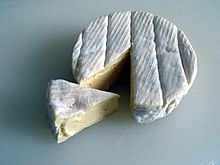Protective culture
A safety culture is a culture of microorganisms involved in the food production is primarily used for the protection of food. It should protect the food from attack by other microorganisms that can spoil it or cause diseases.
Nonspecific protective cultures

Surface cultures of mold or red smear that colonize surfaces and in this way prevent or make further colonization more difficult are referred to as unspecific protective cultures . These cultures are mainly used in the production of cheese or sausage , the mushrooms used usually also have a function as ripening cultures and to develop the taste of the products.
Specific protection cultures
Specific protective cultures are cultures that are specifically used against certain microorganisms, for example when the culture specifically inhibits the growth of certain bacteria through ingredients such as bacteriocins . This includes, above all, preservation by lactic acid bacteria , which in addition to lactic acid also produce nisin as a bacteriocin, which is permitted as a food additive . Nisin has a lytic effect on the cell membrane of various bacteria, especially Listeria , Bacillus species and Clostridia .
literature
- KJ Heller: Microbiology of Food Fermentation. In: Garabed Antranikian (Ed.): Applied Microbiology. Springer-Verlag Berlin and Heidelberg 2006; Pages 522-523. ISBN 978-3-540-24083-9